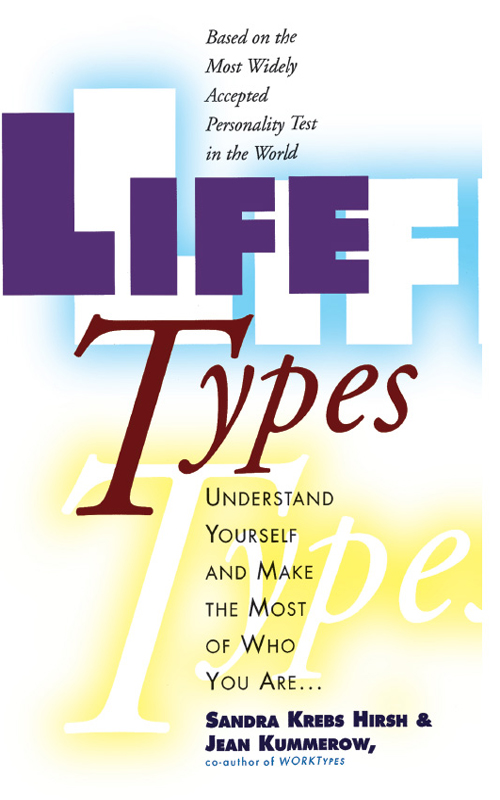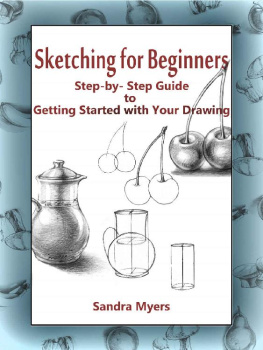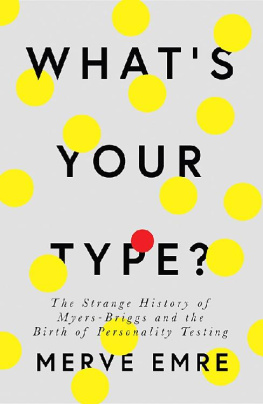Sandra Krebs Hirsh - Lifetypes
Here you can read online Sandra Krebs Hirsh - Lifetypes full text of the book (entire story) in english for free. Download pdf and epub, get meaning, cover and reviews about this ebook. year: 2009, publisher: Grand Central Publishing, genre: Home and family. Description of the work, (preface) as well as reviews are available. Best literature library LitArk.com created for fans of good reading and offers a wide selection of genres:
Romance novel
Science fiction
Adventure
Detective
Science
History
Home and family
Prose
Art
Politics
Computer
Non-fiction
Religion
Business
Children
Humor
Choose a favorite category and find really read worthwhile books. Enjoy immersion in the world of imagination, feel the emotions of the characters or learn something new for yourself, make an fascinating discovery.

- Book:Lifetypes
- Author:
- Publisher:Grand Central Publishing
- Genre:
- Year:2009
- Rating:3 / 5
- Favourites:Add to favourites
- Your mark:
- 60
- 1
- 2
- 3
- 4
- 5
Lifetypes: summary, description and annotation
We offer to read an annotation, description, summary or preface (depends on what the author of the book "Lifetypes" wrote himself). If you haven't found the necessary information about the book — write in the comments, we will try to find it.
Lifetypes — read online for free the complete book (whole text) full work
Below is the text of the book, divided by pages. System saving the place of the last page read, allows you to conveniently read the book "Lifetypes" online for free, without having to search again every time where you left off. Put a bookmark, and you can go to the page where you finished reading at any time.
Font size:
Interval:
Bookmark:

The Myers-Briggs Type Indicator and MBTI are registered trademarks of Consulting Psychologists Press, Palo Alto, California.
Copyright 1989 by Sandra Hirsh and Jean Kummerow
All rights reserved.
Warner Books
Hachette Book Group
237 Park Avenue
New York, NY 10017
Visit our website at www.HachetteBookGroup.com
First eBook Edition: September 2009
ISBN: 978-0-7595-2551-1

Every person is differentbut psychologists around the world agree that all people can be divided into sixteen basic personality types. In LIFETypes consultant Sandra Krebs Hirsh and psychologist Jean Kummerow bring you a complete, step-by-step system for discovering and recognizing:
- why you may be drawn to being a teacher or a writer rather than a doctor or an accountant
- how your personality type reacts to specific situtions using actual case histories
- the way different LIFETypes interact with each othereven when theyre in love
- the inner-dynamics that go into every decision you make
By knowing and and understanding your personality preferencesand those of the people around youyou can make the right choices for your life.
SANDRA KREBS HIRSH, M.A, M.A.I.R, is a Human Resource Development Consultant. Her Minneapolis-based firm provides organizational, leadership, and career development consultation and workshop design and delivery. Sandra is the author or coauthor of more than ten books, and audio- and videotapes, including, most recently, Work It Out! and LifeKeys. Sandra works internationally with small businesses, governmental agencies, nonprofit organizations, and educational institutions. She is a former assistant professor of management at the College of St. Catherine in St. Paul, MN. She is the recipient of the Stoney Career Development Award, a national honor of the American Society of Training and Development.
* * *
JEAN KUMMEROW, Ph.D., is a consulting psychologist with her own firm specializing in leadership/management development, career counseling, and team building. She is staff psychologist to the Blandin Foundations Community Leadership Program, which is designed to develop local leaders from rural Minnesota communities. She trains professionals internationally in the use of several psychology instruments and is the coauthor WORKTypes, MBTI Step II materials, and career-related publications. She is editor of New Directions in Career Planning and the Workplace.
Sandra and Jean also coauthored the widely used Introduction to type in Organizations.
To my husband, Roger Schmidt;
to our children, Katherine, Andrew and Elizabeth Hirsh;
Barbara and Rick Schmidt; and to my mother, Sophie F. Krebs.
SANDRA HIRSH
To my husband, John Loban
and our children, Elizabeth and Rob Loban.
JEAN KUMMEROW
We are indebted to the following people for their careful reading of the chapters and their insight into personality types. Their individual stories and suggestions enriched our book.
Wm. Scott Anchors, Paul Anderson, Robert Bella, Charles Breer, Susan Bidwell, Edwin Braman, Thomas G. Braman, Susan Brock, Helen Bruant, John Buchanan, Ruth Susie Burke, Amanda E. Carlson, Hal Chader, Sue Clancy, Charles Clark, Nicki Davidson, Lynn Davis, Sandra Davis, Larry Demerest, Michael Deis, John K. DiTiberio, Pat Eickmeier, Jeanne Exline, Binnie Ferrand, Peter L. Flint, Penny Pilgram George, Heather R. Gross, Allen Hammer, Carolyn Anita Hartmann, Karen J. Hemphill, Katherine, Andrew and Elizabeth Hirsh, P. William Kirkpatrick, Kay Kummerow, Bonnie Laumb, Rick Laumb, Gordon Lawrence, Lorin Letendre, Lila Lewey, Dr. Charles Lewis, Fiona Lindsay, John Loban, Willy Madsen, Loring W. McAllister, James F. Martin, Mary M. Melbo, Dwight Moore, Terri ODowd, Barbara Olson, Jane Cabak Phipps, Naomi L. Quenk, Ph.D., Rachel Quenk, Connie Reyes, Terry Reyes, Susan Scanlon, Roger Schmidt, David Shores, Kelley A. Sillers, Marj Steele, Carol Stuart, SueLynn, Suzanne M. Swanson, Ann C. Thomas, Alice Toso, Sondra Van Sant, John J. Witek, and Robbin Derksen Walker.
One particular individual, Mary McCaulley, deserves special attention for the foundation in psychological type that she gave to both of us.
Our gratitude is immense and heartfelt for the help of our assistant, Bonnie Laumb, who contributed to every phase and detail of the manuscript preparation with patience, thoroughness, and emotional support.
Finally, to our editor Leslie Keenan, a special thank you for her gentle, yet firm guidanceher collaborative approach with us was appreciated.
This is a book about you. Although you are unique, you have probably noticed that you have some behaviors in common with other people. Conversely, some people have behaviors different from yours. Patterns exist in your behavior, and they are not random. You have a particular type of life because of these patternsyour LIFEType. Other people with patterns similar to yours share your LIFEType. Learning more about your patterns can lead to understanding yourself and others better.
Throughout history, people have developed systems and categories in order to understand one another and to help explain the obvious similarities and differences in people. You may have developed your own way of labeling the patterns you see. Astrology, through the use of birth signs, has long been a popular way of categorizing people. The ancient Greeks had a four-part system by which they characterized individuals: the label sanguine described the cynical person; the label choleric described the mystical and/or idealistic person; the term phlegmatic was applied to the skeptic; and melancholic described the pessimist. American Plains Indians categorized people according to the directions of the compass. Each direction was related to a specific behavior type: North meant innocent; South meant wisdom; East meant imagination and new ideas; and introspection was the quality of the West.
In this book, you will be introduced to still another system. This system is based on a theory about personality types developed by Swiss psychiatrist Carl Jung. Two American homemakers, Katherine Cook Briggs and Isabel Briggs Myers, expanded and elaborated on Jungs theory and developed an inventory to help people determine their psychological type. The Myers-Briggs Type Indicator, which had a humble beginning in the 1920s, is today the most widely used psychological inventory in the world. It is that psychological type theory that we will explain here.
Psychological type is based on the idea that people have preferences. On a very simple level, some people prefer chocolate ice cream and others, vanilla. To get a bit more complex, within each one of us, physical and mental preferences are present. Our physical preferences include such things as our preferred hand, our dominant eye, or the foot with which we generally lead.
To illustrate this graphically, conduct the following simple experiment. Write your name on a piece of paper, first with your preferred hand and then with the other. Compare your thoughts, feelings, and impressions as you carry out these two simple tasks. What differences did you note in your writing?
Although you have two hands, you do prefer to use one over the other. When you used your preferred hand, most likely you found that your writing was easy and natural, and took little effort. Chances are that the resulting writing was what you expected. Writing with your nonpreferred hand most likely was awkward, and took more effort, concentration, and time. Perhaps the result was not what you would have desired. Note, however, that you were able to write your name with either hand when you wanted. If something were to happen to your preferred hand, you probably would begin to use the nonpreferred hand. Through the use of concentration and greater time and effort, the writing could eventually approach that achieved with your preferred hand.
Next pageFont size:
Interval:
Bookmark:
Similar books «Lifetypes»
Look at similar books to Lifetypes. We have selected literature similar in name and meaning in the hope of providing readers with more options to find new, interesting, not yet read works.
Discussion, reviews of the book Lifetypes and just readers' own opinions. Leave your comments, write what you think about the work, its meaning or the main characters. Specify what exactly you liked and what you didn't like, and why you think so.






